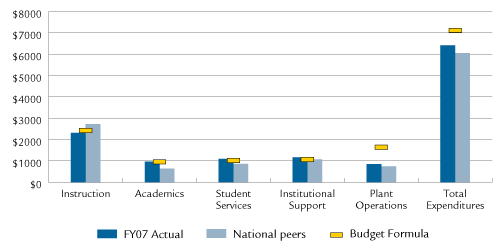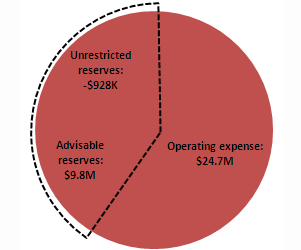Greenfield Community College
Greenfield Community College (GCC) is about teaching and learning together. We teach, in a small, supportive and intimate learning environment, the knowledge and skills necessary for our students to reach their highest potential. Our doors are open to all who seek to learn. In striving to fulfill our mission we also seek to learn the knowledge and skills necessary to reach our highest potential as a college. At GCC, we are passionate about teaching and learning together!
Program of Distinction
Collaborations
Access Indicators
Affordability Indicators
Student Success and Academic Quality Indicators
Fiscal Effectiveness and Efficiency Indicators
Program of Distinction
Greenfield Community College (GCC) continues to lead efforts to meet the high workforce demand for the Sustainable Practices in Construction (SPC) project funded by the Massachusetts Workforce Competitiveness Trust Fund. Collaborating with the Regional Employment Board and over 30 local agencies and businesses, GCC is a leader in Renewable Energy Workforce Education by offering regional business employees comprehensive sustainable energy courses, a Renewable Energy/Energy Efficiency Certificate program started in fall 2008 and, for fall 2009, a Liberal Arts Degree option in Renewable Energy. Statewide recognition over the past year continued to fuel waiting lists while a summer Green Curriculum Development effort for teachers helped address this demand and its associated challenges. A Green Careers Coach increased outreach for adult literacy organizations, other GED or transitions programs, and for unique venues, such as the local house of correction.
Collaborations
- Now in its second year, the Franklin County Public School Project was launched by area legislators to examine ways in which local school districts can improve collaboration with each other and municipalities, and to determine if there is a better way to deliver quality education in Franklin County. A collaborating group comprising legislators, school committee members, municipal officials, superintendents and others meet to discuss the myriad issues facing public education in Franklin County including declining enrollment, insufficient funding and little hope of significant increases in state aid, with a focus on short term budgetary collaborations and longer term visions for providing quality education. Fundamental to the Project is the understanding that small districts, schools and classes have many advantages over their larger counterparts and that Franklin County treasures its community-centered schools. Our legislators secured both state and private funding to help accomplish the Project goals.
- GCC is an active partner in the Northampton Community Education Consortium, convened by the Mayor of Northampton and comprising 23 collaborating partner agencies including the Northampton public school system, Smith Vocational Technical High School, institutions of higher education, the Regional Employment Board, ABE/ESOL providers and the business community. This collaboration strives to overcome the barriers and gaps in services for families and residents to ensure successful education and employment in Hampshire County. Funded by a Pathways to Success by 21 Grant, GCC taught a free four-week college transitions credit course using Smith College facilities in Northampton for 23, at-risk youth and adult learners, several of whom continued on to regional higher education institutions. Due to on-going demand, GCC is re-offering this course and plans to expand educational programming in Hampshire County as the needs and funding sources to support the work continue to be identified.
- With support from our federal legislative delegation and the Department of Elementary and Secondary Education and the Department of Transportation, GCC has partnered with many organizations throughout Franklin County on the Northern Tier Fostering Art and Culture Project. This project raises awareness of the impact of the creative culture and creative economies in Franklin County. Participants strive to foster revenue generation for artists and supporting businesses, research and development of marketing plans, web development and integration, and collaborative sustainability networks for artists. Further, the project educates the regional community about the tight interdependence of multiple economies; the integration of history, tradition and contemporary realities; and increasing awareness of such integration for visitors and tourists.
- As partners in the Northern Tier Health Care Training and Education Project, GCC, BCC and MWCC and their affiliated partner local hospitals (Baystate Franklin Medical Center, Berkshire Health Systems and Heywood Hospital) collaborate to revitalize the clinical component of nursing training and education throughout western Massachusetts. The partnership establishes a process for resource sharing of nursing simulation laboratories. This cooperation will help address the current and projected shortage of Registered Nurses (RN) within the region and will generate a highly replicable model of rural education and industry cooperation. The project is designed to increase the number of RN graduates; support the integration of technology into the nursing curriculum; allow regional health systems to offer comprehensive workforce development sessions to the broad spectrum of its professional staff; and provide clinical and career development opportunities to students through simulation technology that is not uniformly accessible at present. As a result of these activities, RN's entering the workforce and incumbent health care workers will be better prepared to meet the growing demands of the health care sector.
Section I: Access to Public Higher Education in Massachusetts
Access Indicators
Fall 2007 Enrollment
| Headcount |
2,236 |
| FTE |
1,368 |
Fall Enrollment
Over the last three years, fall headcount enrollment has remained relatively stable.
Over the last three years, fall full-time equivalent (FTE) enrollment has remained relatively stable.
Annual 2007–2008 Enrollment
| Headcount |
2,918 |
| FTE |
1,344 |
Annual Enrollment
Over the last three years, annual headcount enrollment has remained relatively stable.
Over the last three years, annual FTE enrollment has remained relatively stable.
Looking Back: Fall and Annual Headcount Enrollment

Fall 2007 Minority Enrollment
9.4%
Minority Enrollment
Comparable to the minority representation of the institution's primary draw cities and towns (10.4%) and lower than the Pioneer Valley Region's minority representation of 16.3%.
Section II: Affordability of Massachusetts Community Colleges
Affordability Indicator
2007–2008 Tuition and Fees as a Percent of Median Family Income
5.7%
% of Median Family Income
Comparable to the Northeast regional average of 4.9%.
Looking Back: Tuition and Fees as a Percent of Median Family Income
|
FY2004 |
FY2005 |
FY2006 |
FY2007 |
FY2008 |
| Greenfield Community College Tuition and Fees |
$3,317 |
$3,647 |
$3,982 |
$4,098 |
$4,488 |
| State Median Family Income |
$67,527 |
$68,701 |
$71,655 |
$74,463 |
$78,497 |
| "X" as a Percent of State Median Family Income |
| X = Greenfield Community College Tuition and Fees |
4.9% |
5.3% |
5.6% |
5.5% |
5.7% |
| X = Massachusetts Community Colleges' Average Tuition and Fees |
4.8% |
4.9% |
4.9% |
4.7% |
4.7% |
| X = Northeast Average Tuition and Fees |
|
4.8% |
4.8% |
4.9% |
4.9% |
Section III: Student Success and Academic Quality
Success and Quality Indicators
Fall 2006 Cohort First-Year Persistence Rate
| Retained at original institution |
54.9% |
| Retained at any institution |
66.5% |
Fall Cohort First-Year Persistence
Persistence at original institution has decreased 4.2 percentage points over the last three years but is comparable to the segmental average of 56.5%.
Looking Back: Fall-to-Fall First-Year Persistence Rate

Fall 2003 Cohort Four-Year Overall Success Rate
79.4%
Fall 2003 Cohort Four-Year Individual Success Rates
| Earned Degree/Certificate |
45.4% |
| Transferred |
13.9% |
| Earned 30 Credits |
18% |
| Still Enrolled |
2.1% |
| Note: Each subsequent category excludes any student included in previous category(ies) |
Fall Cohort Four-Year Overall Success Rate
This new indicator measures students who have earned a degree/certificate, transferred to another institution, earned 30 or more credits, or are still enrolled after four years. Future reports will include these outcomes over four, five, and six years for this and successive cohorts. Please see the Technical Guide for further details regarding this indicator.
2007–2008 Fall-to-Spring Retention Rate
86.7%
Fall-to-Spring Retention Rate
Fall-to-spring retention has declined 2.7 percentage points over the last three years.
FY2008 Credit Course Completion Rate
81.0%
Course Completion
Above the Board of Higher Education's target rate of 75%.
Total Degrees Conferred in FY2008
353
Degrees Conferred
Average degrees conferred per year over the last three years: 348
Looking Back: Degrees Conferred

2007 Pass Rate on the National Nursing Licensure Examination
92.5%
Nursing Exam Pass Rate
Above the Board of Higher Education's target pass rate of 85%.
FY2008 Annual Enrollment in Workforce Development Courses
1,916
Workforce Development
Average annual enrollment in workforce development courses per year over the last three years: 1,758
Section IV: Effective and Efficient Use of Resources
Effectiveness and Efficiency Indicators
Effective Projects and Initiatives
- Received a federal grant of $393,600 and an anonymous gift of $100,000 for the design and construction of a carbon neutral greenhouse.
- Purchased with grant and private funds and installed a second 2kW photovoltaic unit to generate electricity to the East building on the campus.
- Improved HVAC system efficiencies and controls in all facilities to generate energy savings of 5 to 10 percent over budgeted energy costs.
- Began implementation of 'GCC Greener Data Center' utilizing virtual technology to consolidate ten physical servers into three, reducing cooling, energy and physical hardware costs by $66,190, or 82%.
Resource Allocation
Expenditures per Student—Actual, National Peers, and Budget Formula

Note: This graphic was revised on May 6, 2009. The previously posted graphic displayed the data inaccurately.
FY2008 Primary Reserve Ratio
| Unrestricted Reserves (UR) |
-$928,583 |
| Total Operating Expenses (TOE) |
$24,706,036 |
| Primary Reserve Ratio (UR/TOE) |
-3.8% |
Primary Reserve Ratio

Compliance
No materials weaknesses based on annual external independent audit:

